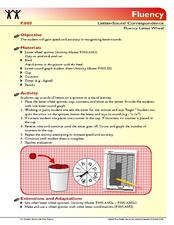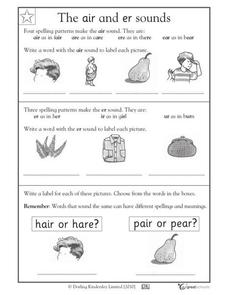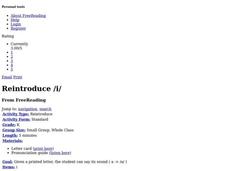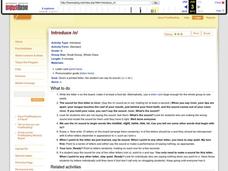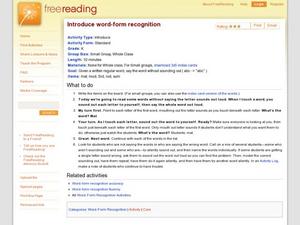Curated OER
Produce Rhyming Words
Have fun creating rhymes! Your class will read the familiar nursery rhyme Three Little Kittens and list rhyming words. They then use the story as a template to develop their own rhymes.
Florida Center for Reading Research
Fluency: Letter-Sound Correspondence, Fluency Letter Wheel
Young scholars spin their way to letter sound fluency. While tomes, pairs spin a spinner and make the sound of the letter on which it lands. They add a counter to their cup for each sound they make correctly. At the end of the game,...
Florida Center for Reading Research
Sound it-Bag it
Scholars sort picture cards based on the initial phoneme they hear as they say the name of each image. They pick a card, say its name, then place it in one of five bags based on how its initial phoneme matches the initial phoneme...
Curated OER
Rhyming Words: Ball and Wall
Preschoolers and kindergartners can identify the pictures that do not rhyme with the lead image. They say each of the four words and then find the image that doesn't belong. In addition, they trace the words ball and wall.
Curated OER
Vowel Sounds: /air/ and /er/
All the best readers started out the same way. Build the foundational skills needed to recognize vowel sounds like /air/ and /er/. Early readers write a word to label each of nine images. Each image focuses on a different spelling...
Curated OER
Where are the Mittens?
Help early readers identify rhyming words in nursery rhymes. They will read the nursery rhyme Three Little Kittens Who Lost Their Mittens in order to identify rhyming words. Then they chart the rhyming words they heard in the...
Curated OER
Beginning Sounds: A is for Ant
The ABC's and beginning letter sounds are the foundation of strong reading skills. Use this presentation to build your young learner's abilities to recognize beginning sounds and alphabet letters. Each slide contains an image and a word...
Curated OER
Using Poetry in Teaching Reading to Special Education Students
A series of well-written activities, these lessons prompt middle schoolers reading below grade level (at a second, third, or fourth grade level) to use poetry to practice basic reading skills. They rhyme, build words, make inferences,...
Curated OER
-air Spelling Pattern
What do hair, chair, and fair all have in common? The -air spelling pattern! Each slide provides both an image and a word that contains the -air sound. Perfect for early readers or to boost spelling success.
Curated OER
Reading Phonetically: /an/ words
What do the words van, man, and pan have in common? The /an/ sound! Reinforce this target sound with this resource, intended for an audience with autism or other special needs. Your learners will see an image and the corresponding word,...
Florida Center for Reading Research
Fluency: Letter-Sound Correspondence, Make a Match
A memory activity engages young learners in letter-sound correspondence. Pairs take turns examining two sets of cards lying face down. They flip one image card and one letter card, then name the initial sound. If the sounds match, pupils...
Florida Center for Reading Research
Rhyme or No Rhyme
Scholars listen to a rhyming song, clap when they hear a rhyme, and shake their heads when they don't. They then draw a pair of objects that rhyme.
Curated OER
Identifying and Generating Rhyming Words, Body
Can you tell which words rhyme? Choose a body part as a starting word (i.e. head) and begin saying words to see if learners can identify those that rhyme. Does red rhyme with head? Continue giving examples, some...
Curated OER
Introduce First Sound Segmenting
Mico is back, and he's ready to test your scholars in initial sounds in single-syllable words. Using a puppet and the picture cards provided (these are great and in full-color), play a game with pre-readers. Hold up three picture cards...
Curated OER
Middle Sound Segmenting Accuracy
Mico the puppet wants to play a game! Can you figure out which picture card he's thinking of if he only says the middle sound? Choose three picture cards from the extensive library provided here, making sure scholars know what word each...
Curated OER
Reintroduce /t/
Use these strategies to connect letter pronunciation, sound, word examples, and recognition, focusing on the letter t. Emerging readers examine the letter and listen to you say the /t/ sound. As you explain how to do it, they try...
Curated OER
Reintroduce /i/
As your scholars begin learning letters of the alphabet, help them connect sound, pronunciation, word examples, and letter recognition using these strategies. Focusing on the letter i, begin by drawing it on the board. Can scholars...
Curated OER
Introduce /n/
What is this letter? Once your class is ready to explore the letter n, use these strategies to combine word examples, pronunciation, and letter recognition. First, can they identify the letter? Make the /n/ sound, explaining...
Curated OER
Reintroduce /e/
These inventive strategies help emerging readers focus on the letter e, forming sound associations along with letter recognition. Explain the mouth movement in making the /eee/ sound, asking learners to try it. Can they think of words...
Curated OER
Reintroduce /x/
What words end with /x/? Unite several alphabet concepts as scholars learn all about the letter x. After identifying it, they listen to you pronounce the /x/ sound and try it themselves (use these tips to explain how you do this)....
Curated OER
Introduce Word-Form Recognition
Sound out sight words using these word cards and word-form recognition strategies. As you point to each word, scholars sound out the letters silently instead of segmenting the sounds aloud. Show them how you do this by mouthing the...
Curated OER
Dd Words
Dinosaur begins with the letter D! Kids find, cut, and paste five pictures that also begin with the letter D. After they cut and paste, they write the name of their pictures in the blanks provided.
Curated OER
Letter Dd: Glue and Write
Cut, paste, and write worksheets are great for employing motor skills, kinesthetic action, and core practice. Kids cut and paste five pictures on their page, that begin with the letter D. They practice writing an upper and lower case D...
Curated OER
Phonics Train: /at/ words
A well-scaffolded phonics resource awaits you and your autistic learners. Phase one in this multi-page document asks, "What is on the train?" The answer is an /at/ word, such as cat, mat, bat, or hat. In Phase two, the train is shown...
Other popular searches
- Identifying Phonemes
- Phonemes Awareness
- Phonemes Segmenting
- Phonemes and Graphemes
- Vowel Phonemes
- Phonemes /Ow/ /Ou/
- Teaching Phonemes
- Middle Phonemes
- Manipulating Phonemes
- Segmenting Words
- Long Vowel Phonemes
- Deleting Phonemes

